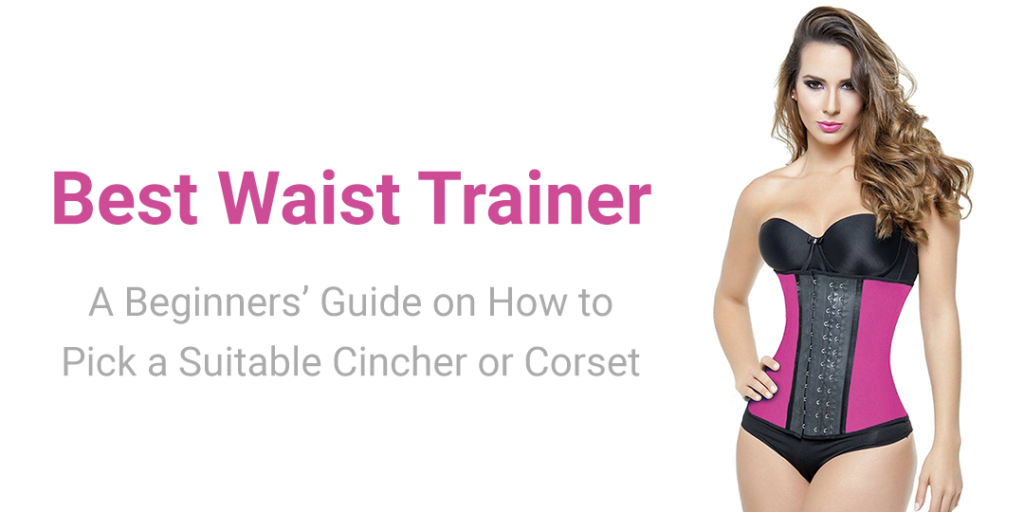
Best Waist Trainer Reviews – Top Corsets & Cinchers of 2020 Home
The best waist trainer for most people is the Lady Slim Latex Waist Cincher. We can say this with confidence after testing out more than 20 different models. If budget isn't a constraint, we recommend the Squeem Perfect Waist instead.
Waist trainers are more than just a hot new fitness trend. The concept has been around ever since the dawn of corsetry, when women (and men) realized that women who wore corsets were more likely to have smaller waistlines.
There are a few reasons for this, with results ranging from the temporary to the semi-permanent. But one truth remains the same: With dedication, waist training will make your waist smaller.
Waist Trainer Reviews - Best of 2020 Home
Colombian Latex Waist Cincher
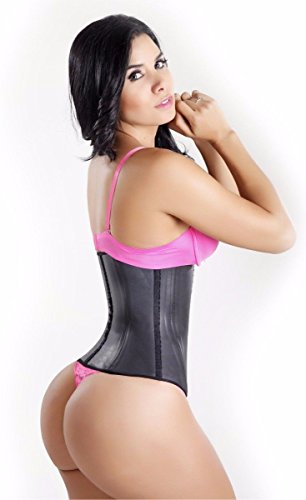
First Impressions - I had to lay down to put it on, but I was happy with the results once it was on my body. It took off 2.75 inches that very day. When I put it on the next day, it took me down 3 inches.
- Thermogenic Effect - sometimes known as the “Sauna Effect”, the thermogenic effect provided by the Colombian Latex Waist Cincher will boost your metabolism during workout and help you target fat burn in your midsection.
- High Quality Build - the reason the Colombian Latex Waist Cincher is so adept at inducing the thermogenic effect is due to the very latex in its name—this is what makes you sweat. Meanwhile, the inner layer absorbs the sweat so you don’t feel gross after working out or wearing it for long periods. Most importantly, this trainer has been made in Colombia for over twenty years. It’s stood the test of time because of the high-quality standards and expert design.
- Waist Training - this trainer is comfortable enough to be worn all day, so it’s safe to use as an all-day waist trainer (as opposed to one that’s only worn during workouts). This can help you achieve quicker, more dramatic results.
- Posture Support - because it’s boned and dramatically cinches in your waist, so that your core and back are supported, which in turn improves your posture by enabling you to sit up straighter, which can be a major challenge for women with large breasts.
Bottom Line - Great for back support and the production standards are high. Also, the company has been making it for 20 years, and products that last a long time tend to be good.
- + It expands up to 5 inches, so if you get super bloated during your period, you won’t feel suffocated
- + Instantly reduces waistline up to 3 inches
- + Made with genuine latex
- + Made in Colombia for over 20 years
- + Three rows of hooks allow you to wear it longer
- - This cincher runs small, so you will likely have to size up. In fact, the manufacturer says so bluntly. This may be annoying to some, but remember it’s not about the size on the label. It’s about you looking and feeling your best!
Squeem “Perfect Waist” Waist Cincher

First Impressions - the hourglass effect was immediate when I put on Perfect Waist for the first time. It took off 3.25 inches immediately. Plus, I worked up a great sweat during my run! It also gets bonus points in my book for being insanely comfortable and helping with my chronic back pain.
- Thermogenesis - The Perfect Waist cincher by Squeem can help you achieve the thermogenic effect by locking in heat to raise your metabolism. This makes it a great aid for weight loss (especially fat loss), where burning more calories than you take in is essential.
- Targets Belly Fat - because the thermogenic effect is concentrated around your waist, and because your waist is being cinched in and trained at the same time, belly fat will likely be the first to go. And this is a big deal, because often, as women, it’s actually our breasts that lose the weight first, and unless you’re a G-cup or bigger, it’s doubtful you’re keen on losing weight from your breasts.
- Smoothens - Perfect Waist isn’t just a waist trainer, it’s also a very functional piece of shapewear. If you plan to waist train for multiple hours most days of the week, you’ll naturally be wearing it under your clothes. This is why the fact it can double as shapewear is so important; it can smooth your body and make your clothes look great while you are waist training. Who doesn’t love metaphorically killing two birds with one stone?
- Shapes - while you’re waiting for the effects of waist training to fully take effect, Perfect Waist gives you an instant hourglass by acting as compression shapewear, cinching in your waist. Essentially, you can have the shape you want all while training your waist to be smaller.
- Improves Posture - Perfect Waist improves posture by providing back support, which is crucial for women with medium to large breasts. This also helps exercise be more effective and less painful.
Bottom Line - A comfortable fit and instant hourglass effect make this an awesome waist trainer!
- + Greatly boosts exercising’s benefits
- + Relieves pain from bad posture or heavy breasts
- + Instant hourglass shape
- + Trains waist to be smaller
- + Hand washable for hygiene
- + Can be worn as shapewear
- + Can be worn all day for heavy-duty waist training or for shapewear purposes
- + Double-rowed hooks for versatility
- - The only downside is that it does contain latex, so if you’re allergic, that’s going to be a problem. Women without latex allergies should be fine, however.
Hourglass Fashion Corset Weight Loss Cincher
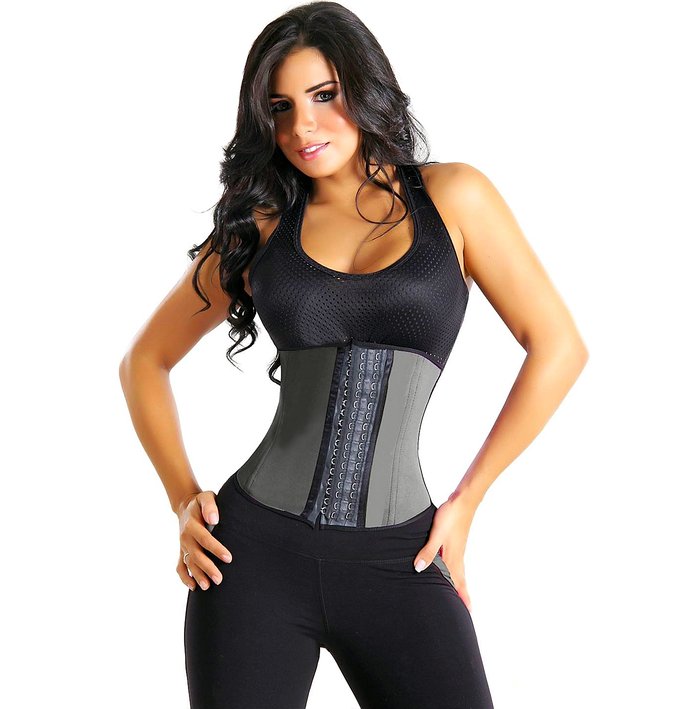
First Impressions - thankfully, I did my research and sized down to a small. When I tried it on, I knew instantly if I’d gone with the medium, it would have been way too big. As far as results go, it definitely slims the waist producing a curvier effect, plus I like the three rows of hooks.
- Instantly Shapes - The Hourglass Fashion Corset Weight Loss Cincher not only trains your waist to be smaller over time, it also instantly cinches in your waist for an immediate effect.
- High Quality Construction - The outer layer is latex for durability and locking in heat, while the inner layer is cotton for comfort. Meanwhile, it also has a total of 9 reinforced steel wire bones to hold the shape of the trainer, upping its longevity tremendously.
- Boosts Workout - By improving blood flow and raising the temperature of your midsection, the Hourglass trainer helps you burn more calories and bust belly fat.
- Back Support - With its cinching and boning, the Hourglass trainer supports your back and core, and helps you stand taller, thereby reducing pain that is common with large breasts and/or poor posture.
Bottom Line - With the wide variety of sizes available, Hourglass’s trainer can be worn by women of many different body types who are looking for that hourglass effect. It’s also a great addition to your workout gear.
- + Hourglass as a brand has a very broad size range from XS to 5XL; this particular trainer is sized XS to XXL
- + “Love it or leave it guarantee” means you get a full refund if you’re not satisfied
- + Three rows of hooks
- + 9 bones — on average that’s 3 more than many cinchers out there
- + Real latex and soft cotton combine for strength and comfort
- + Can be worn all day
- - The main complaint about this trainer is that it runs big, so you’ll likely have to size down. Though, if you get a confidence boost by wearing a smaller size, this isn’t a bad thing, per se.
Ann Chery Women’s Faja Deportiva Workout Waist Cincher
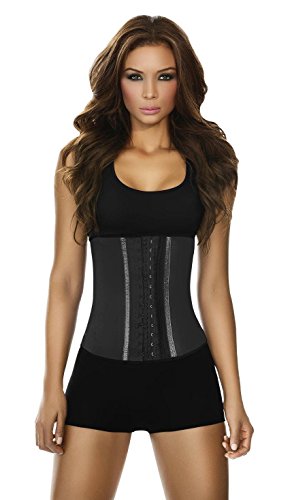
First Impressions - great posture support and provides a wonderful hourglass silhouette.
- Hand Washable - You can hand wash it, so you’re able to stay nice and hygienic after a sweaty workout.
- Cotton Inner Layer - The cotton inner layer protects sensitive skin and wicks away sweat during workouts.
- Latex Outer Layer - The latex exterior is what allows the waist cincher to really do its thing and give that resulting desirable hourglass shape.
- Boning - The flexible boning keeps the waist trainer in place so that it doesn’t ride up, while also supporting your back.
Bottom Line - while running small is annoying, the pros definitely outweigh the cons, and your body looks great during wear.
- Two rows of hooks
- Great supplement to working out
- Immediately takes inches off the waist
- Produces the thermogenic effect to induce fat loss over time with exercise
- Hand washable
- This trainer runs extra small so you may not only have to size up, but maybe even size up twice. However, the point is to get the best fit, so that doesn’t have to deter you.
Waist Trainer Corset by Atbuty
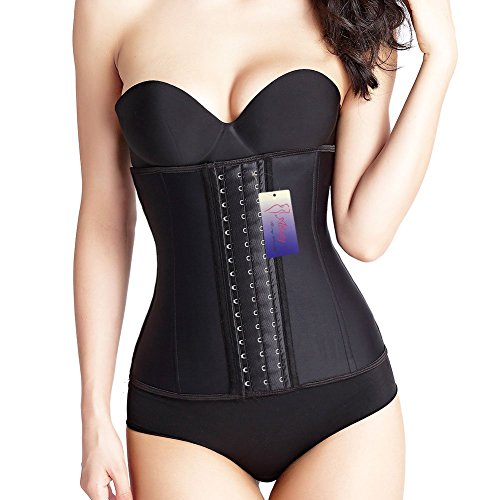
First Impressions - One of the best corsets for its price, this affordable yet powerful waist training corset offers incredible posture support. Also, it cinched me in 3.75 inches on my first use, which looked and felt awesome.
- Extensive Size Range - Atbuty’s size chart was updated in March, 2017, so accuracy is pretty certain. Their sizes range from 3XS to 6XL, which is one of the broadest ranges not only in shapewear, but in womenswear period. This is great for petite and plus women who often aren’t catered to the way average sized women are.
- Instantly Shapes - The compression of this trainer can take off anywhere from 3 to 5 inches the first time you put it on—great for those who need an instant result for a big night out.
- Burns Belly Fat - The thermogenic effect targets tummy fat to blast it away during your workout.
- Quality Construction - Made with latex for durability and cotton to protect your skin, the fabric choices alone are ideal for a cincher. Add 9 flexible steel bones and you have yourself a heavy-duty waist trainer.
Bottom Line - Excellent posture support thanks to comfortable, but sturdy boning; also, great hourglass effect.
- + The steel boning is flexible and supports posture
- + Great for workouts
- + Targets fat at the midsection thanks to thermogenesis
- + Broad size range fits most
- + Can take off up to five inches instantly
- + Hand washable
- - Some find that it runs small, but the updated size chart says to measure an inch above your belly button, which should improve sizing results.
Camellias Women’s 26 Steel Boned Corset

First Impressions - The Steampunk look of this corset trainer is so my style and I can get a lot of cosplay use out of it, too. Also, the lacing was surprisingly easy to do and the fit feels great. Most importantly, it helped my lower back a lot.
- Short Torso - This is a short torso corset, so it’s ideal for petite women, but also great for those with average length torsos, but like the fit and movement the short length provides.
- 26 Steel Bones - By far one of the most comprehensively boned trainers out there, Camellias went all out on this one. The big benefit from this is amazing posture support and a surprising level of flexibility, plus it makes it tough enough to handle tight lacing.
- Instantly Shapes - Because it laces in the back and hooks in the front, you have a more classic level of shaping control, which means you can tight lace if that’s your thing. Don’t tight lace if you haven’t been training for it already; work up to it slowly and safely.
- Back Support - The steel bones are amazing for lumbar support—great for those with back problems.
Bottom Line - Nice waist cinching effect with cool Steampunk looks.
- + Cool Steampunk/Victorian looks
- + Great for cosplay or Halloween
- + Instant hourglass effect
- + 26 steel bones
- + Posture and lumbar support
- - Using a corset-style trainer with laces can be difficult for some to get used to; refer to the manufacturer’s instructions and remember that corsets should never hurt. People spend months and years working their way up to tight-lacing, so it’s more likely if you tried to lace it too tight that you could even damage the product, which is a mistake novices make. You have to season the corset and let it conform to you before you even begin the journey to tight lacing.
Women’s Latex Underbust Waist Trainer Corset
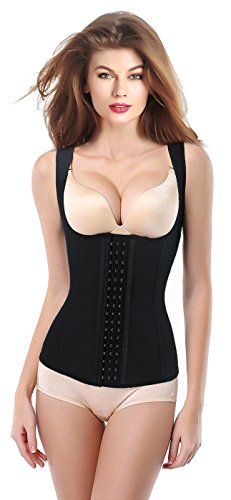
First Impressions - This trainer really pushes the boobs up a good bit, which makes them kind of in-your-face, but it’s also a way to enhance the hourglass look, which is great. Also, the flexibility makes working out easier.
- Plastic Boning - Don’t underestimate the power of plastic boning. In the case of this trainer, it actually improves its flexibility, enabling you to do exercises like yoga, which some trainers are too rigid to do.
- Highly Elastic Latex - The highly elastic latex works with the plastic boning for maximum flexibility.
- Instant Shaping - This trainer can take up three inches off your waist immediately, giving you an hourglass shape.
- 3 Rows of Hooks - The three rows of hooks allow you to wear it longer before sizing down as you progress through your waist training journey.
Bottom Line - Flexible and comfortable — great for working out. Also, great shaping.
- Promotes the thermogenic effect
- Great for exercise
- Cotton interior for comfort
- Absorbs sweat
- Flexible
- Instant 3-inch reduction
- The manufacturer recommends women who already have an hourglass figure (larger breasts and bum) size up.
The Different Types of Waist Trainers

There are two broad categories of waist trainers; each of those two categories contains smaller subcategories of more specific waist trainer styles. But the two major types of waist trainers are:
- Waist trainers or cinchers that are often made with latex and work via compression.
- Corset waist trainers, which are and function much like classic corsets. Though most corsets today are safer than their antiquated counterparts, featuring more intelligent designs and better comfort and movability for the wearer.
Some waist cincher-styled waist trainers are merely designed to make your waist smaller and smoother via compression. Other cincher-styled waist trainers are designed to aid you in working out by providing support or even inducing thermogenesis.
Likewise, there are different varieties of corset-style waist trainers. There are the classic full-length boned corsets that can be used for tight-lacing or slowly training your waist over time. There are also short-length versions that work to the same effect.
While rarer, there are still long-length corsets (known as straight front or S-curve corsets) out there that go down to the to the top of thighs in front and support the bum in the back, for a more dramatic body-shaping effect. However, those largely went out of fashion over a century ago, simply because they’re less comfortable and starting roughly 100 years ago, when women had to work in factories and do other work that was considered “men’s work”.
During WWI, the fashion changed from hobble skirts to shorter, wider mid-calve “war crinolines” and the corsets had to also be more moveable to accommodate women’s dramatically more active lifestyles.
In general, the S-curve corset should be avoided for waist training or back support, because S-curve is exactly what it sounds like—it shapes your spine into an S-curve. The proper shape of the human spine, regardless of gender, is a J-shape.
Typically, corsets and waist trainers that aren’t S-curve corsets (like those mentioned above) can actually help you achieve that J-shaped spine, which is why they’re so much more preferable.
The Benefits of Buying a Waist Trainer
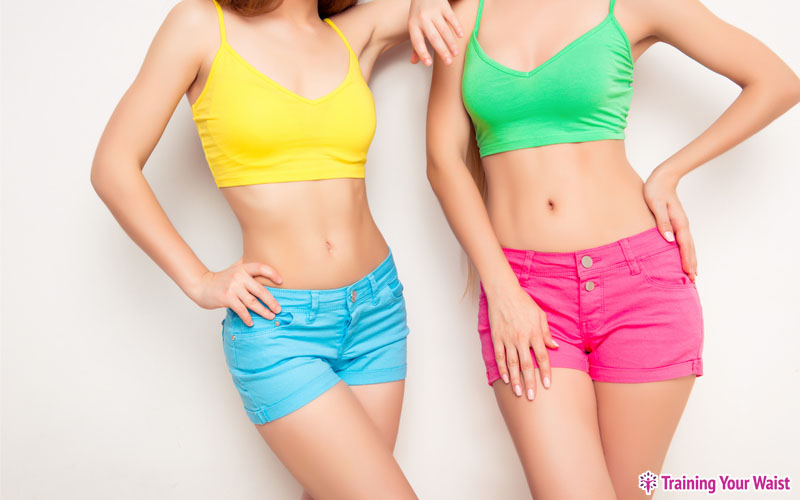
Generally, the main benefit of buying a waist trainer is that it makes your waist smaller. The results are both immediate (in that waist trainers cinch your waist in) as well as semi-permanent (meaning the results will last awhile but fade over time unless you keep using the waist trainer).
Waist trainers also are a great workout aid for two reasons: back support and thermogenesis.
Waist trainers provide back support by correcting your posture. Most Americans, and, indeed, Westerners in general, have S-shaped spines, which are the result of improper posture and poor core strength.
The human spine is meant to be J-shaped which can only be acquired through proper posture and improved core strength. In turn, this better posture improves your workout because you can breathe better, which enables you to work out longer and burn more calories, and it also reduces the risk of injury by supporting your core while you work on building up your core strength in a safe, natural way.
On the thermogenesis front, high-quality waist trainers — especially those with latex, but even other types—can create what is known as the thermogenic effect, whereby the temperature in your abdomen is raised by wearing the waist trainer during your workout.
The thermogenic effect can cause you to burn calories quicker by raising your metabolism temporarily. Of course, you can’t maintain thermogenesis all the time, but it’s perfectly safe during a workout as long as your doctor approves. Furthermore, waist trainers are one of the safest ways to achieve the thermogenic effect.
Most of the other ways involve taking highly toxic “supplements” that can actually be fatal. Waist trainers, on the other hand, only produce thermogenesis during exercise, which means you only have the effect while you need it, upping the safety factor.
As previously mentioned, waist trainers can correct bad posture. This can dramatically reduce back pain from old injuries or the effects of having large breasts. In fact, in relation to having large breasts, waist trainers can be so supportive that not only can they reduce back pain for these women, it can also reduce neck pain and migraines that are also associated with having large breasts. For women who can’t or don’t wish to get a breast reduction, this is a natural, medicine-free way to relieve such pain.
Some women find that waist trainers reduce fatigue. This can be due to the pain relief waist trainers can bring, as well as getting better oxygen flow with the improvement in posture. There are also women who find waist trainers reduce the chronic pain that comes with chronic diseases like lupus and fibromyalgia.
While the latter health benefit can vary even within the chronically ill population, it is worth mentioning, because these are some of the people who suffer most and have the least options when it comes to pain management due to a variety of factors.
Waist trainers can also benefit you by simply putting a spring in your step and giving you the confidence that comes with looking how you want to look. This isn't applicable for things like butt lifters which manage to induce only cosmetic changes on your body.
Finally, waist trainers provide you with an instant hourglass shape. This is great for the short term when you want to look your best for a special occasion, and it’s also great for starting your waist training journey in a healthy way.
What to Look for When Buying a Waist Trainer
The first thing to look at when shopping for waist trainers is which of the two primary types of waist trainer is it: Is it a compression, latex waist cincher-style waist trainer? Or is it a corset-style waist trainer with boning and lacing? Knowing how to spot what you’re looking at if the product description isn’t obvious is key.
When shopping for waist cincher-style waist trainers, the main thing to check out is sizing. Are they one-size fits all (most)? Or do they come in different sizes? They best compression waist cincher-style waist trainers come in multiple sizes so you can get the closest fit.
This is crucial, because it’s key to how they actually work. You need a snug fit, because of the compression factor. Wearing a trainer that’s too loose will slip and it won’t do anything for your appearance or your waist training goals.
Cincher-style waist trainers typically have hook and eye closure in the front; ideally, there should be more than one row. The reason for this is because as women, our bodies are very changeable from day to day. If we’ve eaten salty foods or are on our periods, we could bloat.
Likewise, when we lose weight, it’s typically not in that convenient linear way, but often in stops, starts, rebounds, and then another sudden drop. It’s just how we’re made, which is why more than one hook and eye closer gives you the flexibility you need.
Furthermore, as your waist gets smaller, you have another row of hooks to go down to before you have to get another waist trainer in a smaller size. It’s the same concept with as with bras—you never buy them to fit on the tightest hook, and the same is true with waist trainers.
Latex can be a problem for those with allergies, however it’s a great material for waist cinchers and helps with the thermogenic effect. As long as you’re not allergic, latex is a desirable material choice.
For corset-style waist trainers, there are a few things to look for. Look at the length of the corset. If you have a short torso or you like a high level of movement in your corset, go with a short-length corset.
These short corsets are still usually long enough for the bottom edge to sit below the belly button, depending how long your torso is; they’re longer than the short stays of the Regency and Edwardian eras, which were more bra-like and ended at the rib cage on the bottom edge.
Boning is also more of a consideration with corsets as opposed to waist cinchers. Some types of boning are more flexible than others. Also, some corsets have more bones in them. Whether or not more boning equals a better corset really depends on the overall corset design and what your needs and goals are.
Corsets almost universally have laces, while waist cincher-style waist trainers only sometimes do. Some corset laces are able to be tight-laced—others aren’t. Meanwhile, some corsets aren’t designed for tightlacing anyway, so make sure you educate yourself about the corset you’re looking at, if tightlacing is your goal.
However, it’s important to remember that when corsets are used for waist training, generally speaking, slow and steady wins the race. Not only is it more comfortable, but your waist will actually be trained instead of merely compressed inward. This also gives the corset time to conform to you (also known as seasoning).
Many corsets feature hooks, buttons or snaps in the front so that you can lace the corset and then put it on. Modern women don’t have dressers to dress them like they did in Queen Victoria’s day, so this feature is very important if you’re looking for a corset that’s easy to put on.
Tips on Choosing the Best Shapewear
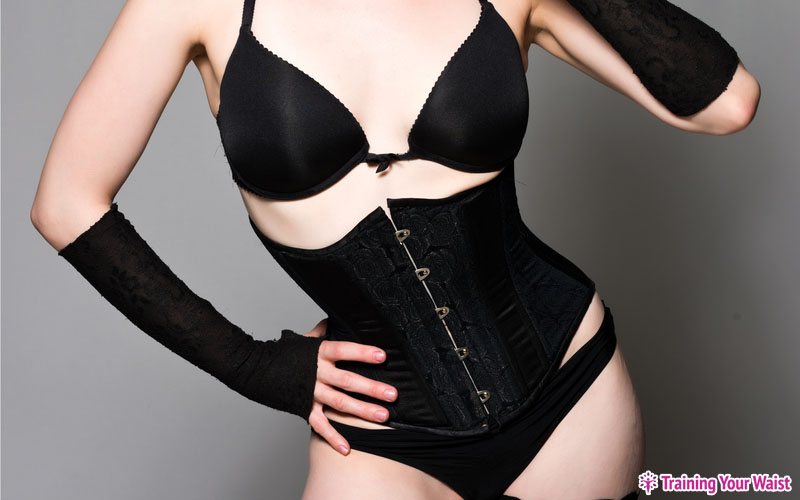
There are a few things you need to keep in mind to find an ideal waist cincher for your needs. Consider the following:
- Firstly, if you’re allergic to latex, you should opt for a latex-free corset-style trainer instead. You’ll still get the thermogenic effect, even if it’s less pronounced—your health is what’s most important.
- If your goal is support during exercise—especially more intensive exercise—opt for the compression waist cincher-style waist trainers. They’re more flexible and they’re designed specifically with exercise and activity in mind. Plus, waist cinchers are more adept at inducing thermogenesis.
- If your goal is waist training to create a smaller waist over time, a waist cincher or a corset will both work, however the corset has the ability to achieve tightlacing.
- Consider how long and how often you’ll be wearing your waist trainer. If your goal is more waist training than exercise support, you’ll need to wear it more often and more hours per day.
- Since the goal of waist trainers is to typically make your waist smaller over time, choose a waist trainer size the same way you choose a bra band size: Never size it to wear on the tightest hook, because you have nowhere else to go but to buy a new waist trainer when your waist becomes smaller. Buying it to fit you on one of the looser hooks buys you time before you have to size down and it also accommodates feminine weight fluctuations that are perfectly normal, albeit annoying. (Note that this advice pertains mainly to the cincher-style waist trainers, because many corset-style waist trainers might only have one row of hooks, but that’s only because the lacing is how you tighten them. The hooks are just to make them easier to put on and take off.)
- If you’re looking for posture support, go for a waist trainer that mentions that benefit. Some of the more flexible waist trainers, while being great for thermogenesis and exercising that involves a lot of movement, aren’t necessarily going to be supportive of posture. That’s not to say that flexible waist trainers can’t provide posture support; rather, to do so they need to have features like light boning or a snug fit to do so. So, that’s an important factor to consider.
- Pay attention to size guides. This is very important, and I've mentioned this several times in the waist trainer reviews part of this round-up. Each brand will have their own sizing scheme and accompanying guide. Sizes aren’t universal across women’s apparel and undergarments in general, and the same is true for waist cinchers. Don’t assume you wear the same size in different brands.
- There may also be additional brand-specific sizing advice. For instance, a manufacturer may recommend that you buy a cincher that is only so many inches smaller than your natural waist for best results. This is because the manufacturers know how much stretch their waist trainers have and this advice is intended to keep you comfortable and safe during waist training.
- For sanitary reasons—especially if you’ll be working out—opt for a waist trainer that can be washed. Hand washing is fine. The point is you need to be able to thoroughly clean the garment, which requires more than simply wiping off the sweat. Typically, high-quality waist cinchers are, at the very least, hand washable.
FAQ (Frequently Asked Questions) about Waist Trainers
Q) Does waist training hurt?
Waist training should NEVER hurt! If you’re hurting, it could be for a few different reasons. The most common of which is that you’re simply pushing your waist training regimen too far and too fast. This is most coming in corset-style waist trainers, because the tight-lacing option can be very tempting when you want your waist to be smaller.
Women who have successfully trained their waists have put months and, in some cases, even years, of dedicated, slow and steady effort into their waist training regimen to produce the semi-permanent effect of a smaller waist and ribcage.
Another reason you could be hurting is that the waist trainer doesn’t fit right. Always refer to the specific size chart and extra sizing advice each waist trainer brand offers to get the best fit.
If your goal is drastically different from your current waist measurement, you should probably start with a trainer closer to your current size and reach a preliminary goal, size down and then repeat that process until you have achieved the results you’re after.
Finally, waist trainers can hurt just because they’re poorly made as well, so always look for one that’s high quality, and always follow any care, handling and seasoning instructions to keep your waist trainer in tip-top shape.
Q) Will waist training make me skinny?
The answer for this is either simple or complicated, depending on what your definition of “skinny” is. If your definition of skinny means, will this make my waist smaller? Then yes, it will, if you follow the usage guidelines. However, if your definition of skinny is more comprehensive, the answer is a little trickier.
Contrary to what many believe, waist trainers CAN make you lose body weight all over, but certain conditions have to be met to achieve this. This is where thermogenesis can help. Because thermogenesis raises the temperature of the core of your body, it boosts your metabolism temporarily.
So, while you’re working out, you’re burning more calories. The fitter you are, the more calories your body burns at rest, too. This can lead to an all-over weight loss and the reason is simple: Total body weight loss is a matter of calories in, calories out.
All of the fad diets out there that say you can eat whatever you want are just ways to trick you into eating less calories without realizing you’re doing it.
And on that note, that’s something that waist trainers can help with. If you wear your waist trainer most of the day, you’ll likely wear it while eating at least two meals a day, if not more. When you wear a waist trainer while eating, the compression on the outside is pushing inward while your stomach is expanding.
When that pressure meet each other, it says to your body, “Hey, I’m full!” Your portions are smaller, which means you take in less calories, which means you will lose overall body weight.
This can be a nice option for those who can’t or won’t count calories. Counting calories takes scales, measuring and dedication. And for some, it may exacerbate eating disorders or mental health issues. So, if you’re looking for a way to naturally reduce portion size while still getting enough food to be healthy, then waist trainers are a good way to achieve that.
All of that said, consult a physician if you’re looking at using waist trainers for massive body weight loss or if you have health issues, mental or physical. It’s important to do whatever weight loss regimen you decide to do—waist trainers included—in a healthy way that makes your whole mind and body better off instead of worse off than when you started. A good doctor can help you make these changes in a healthy way.
Q) I’m an apple shape, and I carry most of my weight in my middle. Can waist trainers make my waist smaller without affecting my hips and bust? (Both of which I would like to keep.) And can I use waist trainers to achieve an hourglass shape?
In short, yes and yes! You might've already gotten a more detailed answer in the waist trainer reviews section, which is - as long as you’re not burning more calories than you’re taking in, you’re not likely to lose fat. Rather, the waist trainer will redistribute the fat you have, training it to move away from the waist and create more of an hourglass shape.
Q) How do I know what size I wear?
Most manufacturers will have a size chart and additional sizing advice that is specific to their brand or even that particular waist trainer, as there can be variations of different models even in the same brand.
If you’re still unsure, contact a representative from the company to ask for further assistance. Many companies employ people specially trained to offer sizing and fit advice.
Q) I’m in between two sizes: Should I size up or size down?
Generally, manufacturers understand this is a common sizing issue many will already have a prepared answer for this in their sizing advice. Failing that, because waist trainers compress fat, many choose to size down.
Typically, the gaps between sizes aren’t that big, so sizing down shouldn’t be a huge issue unless it’s a garment that doesn’t have any adjustments or much stretch, but that would be unusual for waist trainers.
If you’re still stuck in between sizes, you have two options: 1.) Re-measure yourself following the manufacturer’s instructions precisely because your weight could have fluctuated or you never measured correctly in the first place; 2.) Try a different brand. Unlike men’s apparel, women’s sizing is very subjective. Any woman who’s had to buy a bra online knows this.
Need more proof that sizing in women’s apparel has run amok and is totally arbitrary? Consider that Marilyn Monroe was a size 16 at her heavier weight back in the mid-twentieth century; that’s the modern-day equivalent of a US ladies 6 or 8.
This has led to the common misconception that Marilyn Monroe was a plus size gal, when even at her heaviest, she was still the same size as many of the fit and healthy female celebrities are today.
Q) Can waist trainers contribute to bettering my self-image and gaining confidence?
In short, yes, they absolutely can! There’s a lot of problems with our world, but we’re lucky to be alive today, living in this time. And you know why? Now, more than ever, people have the freedom to choose to look how they want to look. More importantly, they are less likely to be shamed for that than people were in the past.
For so long, those who didn’t fit the “ideal body type” were bullied, treated cruelly and told to change. This has shattered the self-confidence of entire generations of women and girls.
Women who were skinny were told to go eat something and gain weight; women who were bigger girls were told to lose weight, or told passive-aggressively, “You’d be such a pretty girl if you lost some weight.”
While the days of comments like that aren’t entirely over, the body-confidence movement is only just getting started. Instead of being told it’s only acceptable to look one way, women (and men) are now being told they can look whichever way makes them feel best inside and out.
As a society, we’ve begun to realize that health—physical, mental and emotional—is most important when it comes to body image and outward appearance. Healthy is beautiful. As long as you’re not harming yourself, you have a right to choose how you want to look. And that, my friends, will help you gain confidence.
So, to answer this question, if you’ve always wanted a smaller waist, and that is what makes YOU feel more confident, then YES, a waist trainer can certainly improve your self-image. And the end of the day, it’s all about what makes YOU feel good. When you feel good, your confidence will soar.
Q) Aren’t waist trainers and corsets sexist and archaic?
No, of course they aren’t! What’s sexist and archaic is the notion that anyone has the right to tell a woman how she should look or what she should wear. Telling women that waist trainers and corsets are sexist and archaic is just as sexist and archaic as telling women they can’t wear pants or have short hair.
The only true way to be empowered as a woman is to be in charge of your life, all the way down to your outward appearance. Often, women are pressured by other women to look or dress a certain way; believe it or not, it’s way more common that this pressure comes from women than from men.
When a man tells a woman how to look, it’s a warning sign of an abusive relationship, telling her to get out now. But women telling other women how they should look is a downright epidemic of abuse and anti-feminism, and it is confidence-shattering.
If corsets and waist trainers are your thing, wear them with pride. And if they aren’t, well, I doubt you’re reading this anyway. The point is, the most modern, healthy and empowered thing you can do as a woman is make your own choices. So, if waist training is YOUR choice, then you go girl.
Final Verdict
After reviewing several of the top waist trainers on the market today, a clear winner emerged for the title of the best waist trainer of 2020. The winner of the roundup is the Squeem “Perfect Waist” Firm Compression Waist Cincher Shapewear.
Perfect Waist was chosen because it provides results and is comfortable—especially during workouts. Plus, it looks great under clothes and is wearable for long periods. I’d recommend Squeem’s Perfect Waist to any woman looking into waist training!
